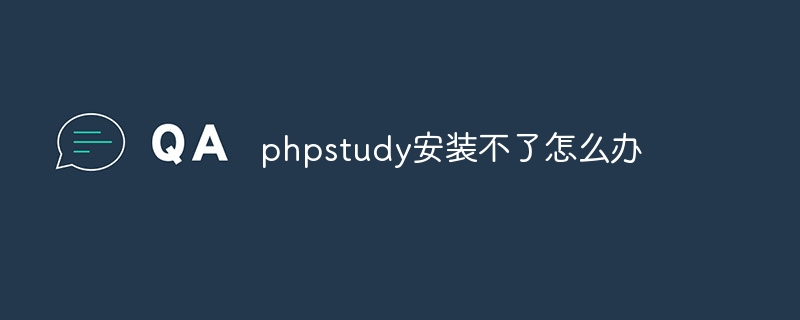PHPStudy is a software suite that can quickly build a PHP development environment in a Windows environment. It installs Apache, PHP, and MySQL environments with one click, which can greatly accelerate the local development efficiency of PHP.
The MySQL database is a very important part. How to use the MySQL database correctly in PHPStudy? This article will introduce you to the use of MySQL in PHPStudy.
1. Install PHPStudy
First we need to download and install PHPStudy. The official download address is: http://www.phpstudy.net/download. html. Select the corresponding version to download and install, and select the default installation path during the installation process.
2. Start the MySQL database service
After installing PHPStudy, double-click the PHPStudy icon on the desktop, you will see that the related services have been started, among which the MySQL database service is by default is closed. We need to click on the server management interface to enter the backend interface, click on the MySQL option in the left menu bar, and then click on the Start MySQL button. The MySQL database will be started successfully.
3. Connect to the MySQL database
After starting the MySQL database, we need to use MySQL in the PHP code to operate. Before connecting to the database in the code, we need to confirm the database first connection information. Open the MySQL/bin directory in the root directory of PHPStudy and find the mysql.ini file. The connection information of MySQL can be viewed in this file, for example:
[client] port=3306 default-character-set=utf8 [mysql] default-character-set=utf8 [mysqld] port=3306 character-set-server=utf8
From the above content, we can see that the port number of MySQL is 3306 and the character set is utf8. In the PHP code, you need to use this connection information to connect to the MySQL database. The specific code is as follows:
<?php $host = 'localhost';
$user = 'root';
$password = 'root';
$dbname = 'test';
$port = 3306;
$conn = mysqli_connect($host, $user, $password, $dbname, $port);
if (!$conn) {
die('Could not connect: ' . mysqli_error());
}
mysqli_select_db($conn, $dbname);
mysqli_set_charset($conn, 'utf8');
?>
In the above code, $host is the host name, you can also use the IP address, $user is the database user name , $password is the password, $dbname is the database name, $port is the port number of MySQL. The mysqli_connect() function is used to connect to the MySQL database, the mysqli_select_db() function is used to select the database, and mysqli_set_charset() is used to set the character set. These are all operations that must be completed to connect to the database.
4. Operation of MySQL database
In PHPStudy, we have successfully connected to the MySQL database, and then we can operate the MySQL database. The following code is just an example for everyone to understand the operation of a basic MySQL database.
<?php require_once('dbconnect.php');
$sql = "SELECT * FROM `users` WHERE `name` = 'test'";
$result = mysqli_query($conn, $sql);
if (!$result) {
die('Error: ' . mysqli_error($conn));
}
while ($row = mysqli_fetch_array($result)) {
echo $row['name'] . "<br/>";
}
?>
In the above code, we first connect to the database through the require_once() function, then use the SELECT statement to query the user named test in the user table (users), and finally display the results on the page. The mysqli_query() function is used to execute SQL statements, and the mysqli_fetch_array() function is used to obtain query results.
5. Summary
Through the above introduction, we can see that using the MySQL database in PHPStudy is very simple and convenient. You only need to master the basic connections and operations. Just use the method. Of course, there are also more advanced applications, such as how to ensure the security of MySQL database, optimize the performance of MySQL database, etc. I believe that as long as you continue to learn and practice, you will become an expert in MySQL database and lay a solid foundation for your PHP application development.
The above is the detailed content of Let's talk about how to use MySQL in PHPStudy. For more information, please follow other related articles on the PHP Chinese website!
 phpstudy pro怎么安装Apr 02, 2024 pm 03:15 PM
phpstudy pro怎么安装Apr 02, 2024 pm 03:15 PMPHPstudy Pro 是一款 Web 开发环境软件包,可快速部署和测试 Web 应用。安装步骤如下:从官方网站下载安装包。运行安装程序,选择安装路径和语言。安装完成后,启动 PHPstudy 并配置 PHP、MySQL、Apache 设置。验证安装,在浏览器输入“localhost”或运行命令“php -v”检查 PHP 版本。
 phpstudy乱码怎么办Nov 14, 2022 am 09:53 AM
phpstudy乱码怎么办Nov 14, 2022 am 09:53 AMphpstudy乱码是因为编码与译码的方式不一致,其解决办法:1、打开“控制面板”;2、打开“时钟,语言和区域”;3、点击“区域”;4、在小窗口上点击“管理”图标;5、点击“更改系统区域设置”,选择“具体的语言”,然后点击“确定”;6、重启电脑即可。
 phpstudy为什么安装不了Apr 02, 2024 pm 03:42 PM
phpstudy为什么安装不了Apr 02, 2024 pm 03:42 PMPHP Study安装失败可能是由于以下原因:1.系统兼容性问题;2.权限不够;3.文件冲突;4.网络连接异常;5.防病毒软件干扰;6.路径问题;7.系统错误。如遇问题无法解决,可通过PHP Study论坛、GitHub或官方网站寻求支持。
 phpstudy配置文件怎么改Apr 02, 2024 pm 03:57 PM
phpstudy配置文件怎么改Apr 02, 2024 pm 03:57 PM可以通过以下步骤修改 phpStudy 配置文件:找到配置文件(Windows:C:\Windows\phpStudy\php\php.ini;Mac:/Applications/phpStudy/php/php.ini)使用文本编辑器打开并查找要修改的设置编辑设置的值,如修改时区:date.timezone = Asia/Shanghai保存更改并重启 Apache 服务
 phpstudy怎么改变端口Apr 02, 2024 pm 04:24 PM
phpstudy怎么改变端口Apr 02, 2024 pm 04:24 PM为了更改 PHPSTUDY 端口,可通过以下步骤:打开控制面板并定位到内建 Web 服务器设置;修改端口号字段中的数字;保存更改并重启服务器;输入网站 URL 及新端口号验证更改。
 phpstudy怎么看数据库Apr 02, 2024 pm 04:06 PM
phpstudy怎么看数据库Apr 02, 2024 pm 04:06 PM通过 PHPstudy 查看数据库的方法包括:直接连接 MySQL 命令行使用 MySQL Workbench配置连接选择要查看的数据库通过 PHPMyAdmin在左侧菜单中选择要查看的数据库
 教你创建虚拟主机并运行php项目(phpstudy + wamp)Aug 07, 2022 pm 03:17 PM
教你创建虚拟主机并运行php项目(phpstudy + wamp)Aug 07, 2022 pm 03:17 PM本文涉及两款php的集成环境,这两款都含mysql + apache + php,phpstudy的功能比wamp要强大,并且十分简单容易上手。
 phpstudy安装不了怎么办Apr 02, 2024 pm 04:03 PM
phpstudy安装不了怎么办Apr 02, 2024 pm 04:03 PM无法安装 phpStudy 的解决方法:检查系统要求是否符合。禁用杀毒软件。关闭防火墙。以管理员身份运行安装程序。修复损坏的文件:sfc /scannow。尝试使用替代安装程序。联系 phpStudy 技术支持。


Hot AI Tools

Undresser.AI Undress
AI-powered app for creating realistic nude photos

AI Clothes Remover
Online AI tool for removing clothes from photos.

Undress AI Tool
Undress images for free

Clothoff.io
AI clothes remover

AI Hentai Generator
Generate AI Hentai for free.

Hot Article

Hot Tools

Dreamweaver Mac version
Visual web development tools

VSCode Windows 64-bit Download
A free and powerful IDE editor launched by Microsoft

MinGW - Minimalist GNU for Windows
This project is in the process of being migrated to osdn.net/projects/mingw, you can continue to follow us there. MinGW: A native Windows port of the GNU Compiler Collection (GCC), freely distributable import libraries and header files for building native Windows applications; includes extensions to the MSVC runtime to support C99 functionality. All MinGW software can run on 64-bit Windows platforms.

PhpStorm Mac version
The latest (2018.2.1) professional PHP integrated development tool

SAP NetWeaver Server Adapter for Eclipse
Integrate Eclipse with SAP NetWeaver application server.






